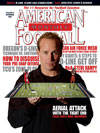AMERICAN FOOTBALL MONTHLY THE #1 RESOURCE FOR FOOTBALL COACHES
Article CategoriesAFM Magazine
|
Oregon\'s Defensive Line Prep vs. the Shotgun Spread Offenseby: Michael Parker© More from this issue In recent years, there has been a major shift back to the old-school principles of the past. More and more teams at the high school and college level are turning to athletic QBs and more option based systems to take advantage of the way defenses play against multiple WR formations. For coaches like Oregon D-Line Coach Michael Gray, it means new drills and rules to work on with his linemen. The premise behind these spread-type systems is that an offense can account for defenders by using the QB as an extra ball carrier. And by utilizing several WRs in the initial alignment, the defense is forced to commit defenders to cover more ground. By so doing, the offense can create mismatches with the defense since a QB and RB standing next to each other in the shotgun are basically the same as having two RBs behind the QB in a more tradit....The full article can only be seen by subscribers. Subscribe today!
|
|
|||||||
| HOME |
MAGAZINE |
SUBSCRIBE | ONLINE COLUMNISTS | COACHING VIDEOS |
Copyright 2025, AmericanFootballMonthly.com
All Rights Reserved





